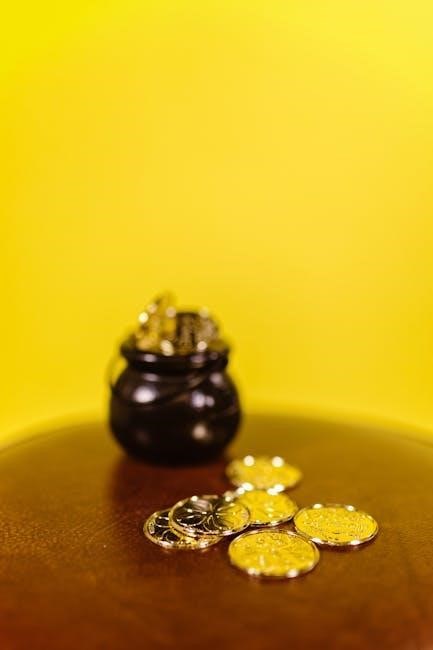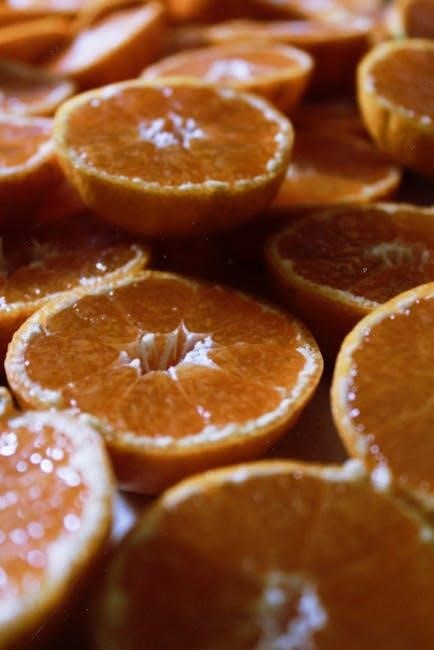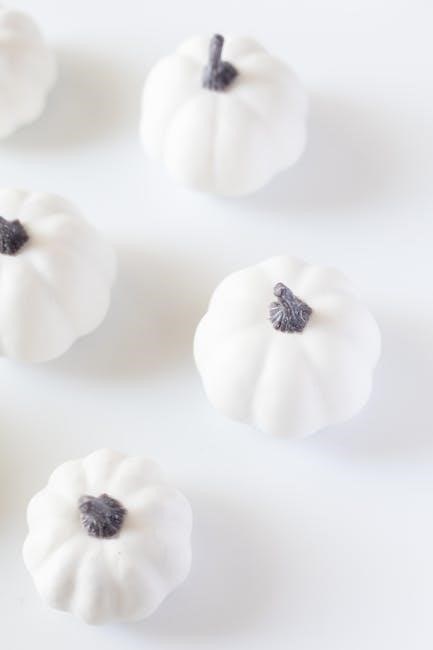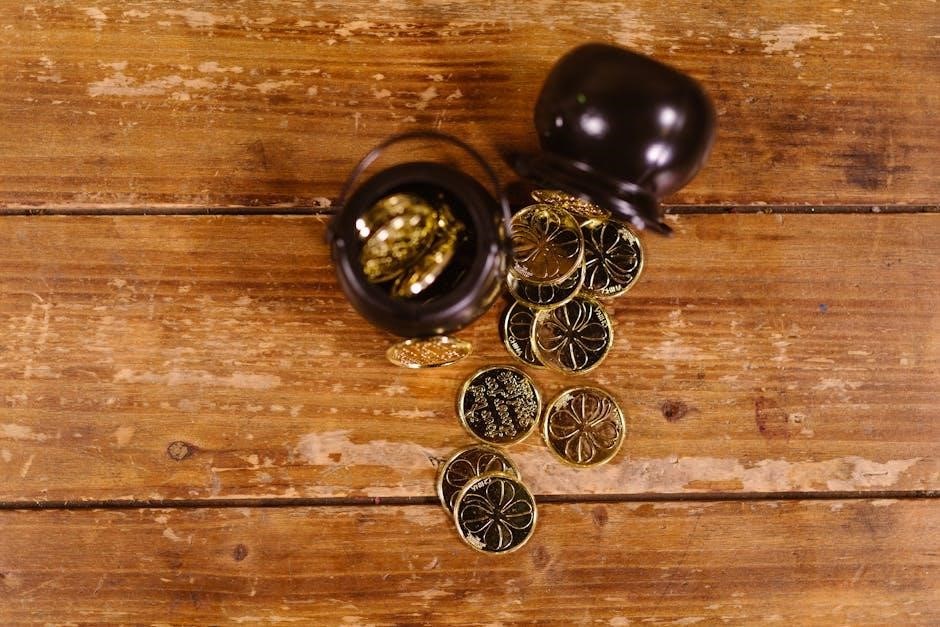Iron-rich foods are essential for maintaining health and energy levels. Discover a comprehensive guide‚ including a downloadable PDF table‚ to explore top sources and benefits effectively.
1.1 Importance of Iron in the Diet
Iron is a vital nutrient essential for oxygen transport and energy production. It supports immune function‚ cognitive health‚ and combats fatigue and weakness. According to sources like ANSES and the Swiss Nutrition Society‚ inadequate iron intake can lead to deficiency‚ causing symptoms like hair loss and pale skin. Incorporating iron-rich foods into your diet is crucial for maintaining overall well-being and preventing these issues. Refer to the downloadable PDF table for a detailed list of iron-rich foods and their benefits to make informed dietary choices.
1.2 Benefits of Consuming Iron-Rich Foods
Consuming iron-rich foods offers numerous health benefits‚ including enhanced energy levels‚ improved cognitive function‚ and strengthened immunity. Iron aids in transporting oxygen to cells‚ supporting physical performance and mental clarity. A diet rich in iron can also promote healthy skin‚ hair‚ and nails‚ reducing the risk of anemia and related symptoms like fatigue. For a personalized approach‚ consult the downloadable PDF table‚ which outlines key iron-rich foods and their nutritional values‚ helping you create a balanced and iron-sufficient diet tailored to your needs. Regular consumption ensures optimal bodily functions and overall well-being‚ making it a cornerstone of a healthy lifestyle.

Top Animal-Based Sources of Iron
Blood sausage‚ chicken heart‚ cooked oysters‚ grilled beef liver‚ and cooked ground beef are rich in iron‚ essential for a balanced diet and preventing deficiencies.
2.1 Blood Sausage (Boudin Noir)
Blood sausage‚ or boudin noir‚ is a nutrient-dense food rich in iron‚ with about 5.5 mg per 100 grams. It’s made from pork blood‚ meat‚ and spices‚ offering a hearty source of heme iron‚ which is easily absorbed by the body. This traditional dish supports blood health and energy levels. Pairing it with vitamin C-rich foods enhances absorption. Its unique flavor and versatility make it a popular choice in various cuisines. Including it in meals can help meet daily iron needs effectively.
2.2 Chicken Heart

Chicken hearts are a rich source of iron‚ providing about 6.5 mg per 100 grams. They are high in protein and contain heme iron‚ which is easily absorbed by the body. Chicken hearts are versatile and can be cooked in various ways‚ such as grilling or sautéing. They are also low in calories and rich in essential nutrients like zinc and B vitamins. Incorporating chicken hearts into meals supports overall health and helps maintain healthy red blood cells. Pairing them with vitamin C-rich foods enhances iron absorption.
2.3 Cooked Oysters
Cooked oysters are one of the richest sources of iron‚ with about 13.8 mg per 100 grams. They are packed with heme iron‚ which is highly bioavailable. Oysters also provide protein‚ zinc‚ and antioxidants‚ making them a nutritious choice. They are low in calories and versatile for various recipes‚ such as steaming or baking. Pairing oysters with vitamin C-rich foods can enhance iron absorption. Incorporating cooked oysters into meals supports healthy red blood cells and overall well-being‚ making them an excellent addition to an iron-rich diet.
2.4 Grilled Beef Liver
Grilled beef liver is an iron-rich superfood‚ providing about 6.5 mg of iron per 100 grams. It is also packed with vitamin A‚ B vitamins‚ and protein. This nutrient-dense food supports energy production and immune function. Grilling enhances its flavor while retaining its nutritional value. Pairing beef liver with vitamin C-rich foods can boost iron absorption. Incorporating grilled beef liver into meals is an excellent way to meet daily iron needs and promote overall health.

2.5 Cooked Ground Beef
Cooked ground beef is a reliable source of iron‚ containing approximately 3.9 mg per 100 grams. It is also rich in protein‚ zinc‚ and B vitamins‚ making it a nutritious addition to meals. Opting for leaner cuts reduces fat content while retaining iron. Seasoning with herbs like garlic or onion can enhance flavor. Pairing ground beef with vitamin C-rich foods boosts iron absorption. This versatile ingredient is ideal for dishes like meatballs‚ burgers‚ or tacos‚ ensuring a balanced and iron-rich diet.

Top Plant-Based Sources of Iron
Plant-based iron sources include lentils‚ spinach‚ beans‚ tofu‚ and fortified cereals; Pairing these with vitamin C-rich foods enhances absorption. Herbs like thyme and basil also contribute iron.
3.1 Dried Thyme
Dried thyme is a potent plant-based source of iron‚ offering 1.25 mg per ounce. This aromatic herb is versatile‚ enhancing dishes like soups‚ stews‚ and vegetable recipes. Thyme’s iron content supports blood health and energy levels. Pairing it with vitamin C-rich foods boosts absorption. Its mild flavor makes it an excellent addition to iron-rich diets. Incorporating dried thyme into meals provides a natural way to meet daily iron needs while adding culinary depth and nutritional value to various recipes.
3.2 Dried Basil
Dried basil is a flavorful herb rich in iron‚ providing approximately 3.1 mg per 100 grams. It enhances Mediterranean and Italian dishes with its aromatic taste. Rich in antioxidants‚ dried basil supports overall health and boosts iron intake naturally. To maximize absorption‚ pair it with vitamin C-rich foods like tomatoes or citrus. Incorporating dried basil into recipes not only adds culinary appeal but also contributes to meeting daily iron requirements‚ making it a versatile and nutritious addition to iron-rich diets.
3.3 Dried Mint
Dried mint is a nutrient-rich herb that contains approximately 2.5 mg of iron per 100 grams. It is a popular addition to teas‚ salads‚ and Middle Eastern dishes. Mint is not only a good source of iron but also packed with antioxidants and vitamins. To enhance iron absorption‚ dried mint can be paired with vitamin C-rich foods like citrus or tomatoes. Incorporating dried mint into meals supports blood health and digestion‚ making it a valuable herb for iron-rich diets and overall wellness.
3.4 Meloukhia
Meloukhia‚ also known as Jew’s marrow or Egyptian spinach‚ is a nutrient-dense leafy green rich in iron‚ containing approximately 2.5 mg per 100 grams. Native to the Middle East and Africa‚ it is often used in soups‚ stews‚ and sautéed dishes. Meloukhia is not only a good source of iron but also provides vitamins A and C‚ which support immune function and collagen production. Incorporating meloukhia into meals can enhance iron intake and contribute to overall nutritional balance‚ making it a valuable addition to iron-rich diets.
3.5 Cumin

Cumin is a spice rich in iron‚ containing about 1.5 mg per tablespoon‚ making it a valuable addition to iron-rich diets. Originating from the Middle East and India‚ cumin is widely used in culinary dishes for its distinct flavor. It not only enhances taste but also aids in digestion and iron absorption. Incorporating cumin into meals can boost iron intake naturally. Pairing it with vitamin C-rich foods further enhances its benefits‚ making it a practical choice for improving overall iron levels in the body.

Maximizing Iron Absorption
Maximizing iron absorption is crucial for maintaining optimal health. Combining iron-rich foods with vitamin C enhances uptake‚ while avoiding inhibitors like coffee and tea improves utilization.
4.1 Pairing Iron-Rich Foods with Vitamin C
Pairing iron-rich foods with vitamin C significantly enhances absorption. Foods like citrus fruits‚ tomatoes‚ and peppers contain vitamin C‚ which converts iron into a more absorbable form. For example‚ eating spinach with orange slices or adding lemon juice to lentils boosts iron uptake. This strategy is particularly effective for plant-based iron sources‚ as it helps overcome natural inhibitors. Combining iron-rich foods with vitamin C ensures maximum nutrient benefit‚ supporting overall health and energy levels.
4.2 Avoiding Inhibitors Like Coffee and Tea
Coffee and tea contain polyphenols‚ which can inhibit iron absorption by binding to iron in the gut. Consuming these beverages with iron-rich foods significantly reduces absorption; To maximize benefits‚ avoid drinking coffee or tea within two hours of eating iron-rich meals. Instead‚ opt for water or vitamin C-rich drinks to enhance absorption. Limiting these inhibitors ensures better iron utilization‚ promoting overall health and preventing deficiency risks.
4.3 Cooking in Cast Iron Cookware
Cooking in cast iron cookware can naturally increase iron intake‚ especially for individuals with deficiencies. The metal leaches into food during cooking‚ particularly when preparing acidic dishes like tomatoes or citrus-based recipes. This method is beneficial for enhancing dietary iron without additional supplements. Regular use of cast iron cookware can help maintain healthy iron levels‚ supporting energy and immune function. It’s a simple‚ effective way to boost iron absorption in everyday meals.

Foods to Avoid for Better Iron Absorption
Certain foods inhibit iron absorption‚ such as black tea‚ coffee‚ and red wine‚ due to compounds like polyphenols and tannins. Limiting these aids better nutrient uptake.
5.1 Black Tea
Black tea is a common inhibitor of iron absorption due to its high tannin content. Tannins bind to iron‚ reducing its bioavailability‚ especially in plant-based diets. Consuming black tea with iron-rich meals can significantly lower iron uptake. To minimize this effect‚ it is advisable to drink black tea between meals rather than with iron-rich foods. Moderate consumption is recommended‚ particularly for individuals at risk of iron deficiency. Awareness of this interaction is crucial for optimizing dietary iron absorption.
5.2 Coffee
Coffee is another common inhibitor of iron absorption due to its polyphenol content. These compounds can bind to iron‚ particularly non-heme iron found in plant-based foods‚ reducing its absorption. Drinking coffee with iron-rich meals significantly lowers iron uptake. To mitigate this‚ it is recommended to consume coffee at least one hour before or after eating iron-rich foods. Moderation is key‚ especially for those at risk of iron deficiency. Balancing coffee intake with iron-rich diets is essential for maintaining proper nutrient absorption.
5.3 Red Wine
Red wine contains polyphenols‚ particularly tannins‚ which can inhibit iron absorption. These compounds bind to iron‚ reducing its bioavailability‚ especially from plant-based sources. Drinking red wine with iron-rich meals can significantly lower iron uptake. To minimize this effect‚ it is advised to consume red wine separately from iron-rich foods. Moderation is key‚ especially for individuals with iron deficiency. Balancing red wine consumption with iron-rich diets can help maintain optimal nutrient absorption and overall health.
Iron-Rich Foods for Hair and Health
Iron-rich foods play a vital role in maintaining healthy hair‚ skin‚ and overall well-being by supporting essential bodily functions and nutrient delivery.
6.1 Promoting Hair Growth
Iron-rich foods are essential for promoting hair growth by nourishing hair follicles and preventing brittleness. Foods like spinach‚ lentils‚ and dried herbs provide iron‚ which supports hemoglobin production‚ ensuring oxygen reaches hair roots. Incorporating lean meats‚ such as chicken or turkey‚ also boosts hair health. Iron deficiency can lead to hair loss‚ making these foods vital for maintaining strong‚ healthy hair. Pairing iron-rich foods with vitamin C enhances absorption‚ further benefiting hair growth and overall scalp health.
6.2 Strengthening Nails
Iron-rich foods play a vital role in strengthening nails by preventing brittleness and nail ridging. Incorporating iron-rich plant-based foods like lentils and spinach helps maintain healthy nails. Iron supports hemoglobin production‚ ensuring oxygen reaches nail cells. Pairing these foods with vitamin C enhances absorption‚ promoting stronger nails. A diet rich in iron can improve nail health and reduce the risk of nail-related issues‚ contributing to overall well-being. Regular consumption ensures nails remain strong and less prone to breakage.
6.3 Improving Skin Health
Iron-rich foods significantly contribute to improving skin health by supporting oxygen transport and collagen production. Iron deficiency can lead to pale‚ dull‚ or sallow skin. Incorporating foods like lentils‚ spinach‚ and red meat helps maintain healthy skin tone and texture. Adequate iron intake also reduces the risk of skin conditions such as acne and eczema. Pairing iron-rich foods with vitamin C enhances absorption‚ promoting glowing and resilient skin. A balanced diet ensures optimal skin health and a youthful appearance.
Downloadable Iron-Rich Foods Table (PDF)
A convenient downloadable PDF table lists iron-rich foods‚ serving sizes‚ and iron content per portion. It helps plan meals efficiently and track daily iron intake.
7.1 How to Create a Personalized Table
To create a personalized iron-rich foods table‚ start by listing your preferred foods and their iron content per serving. Use a spreadsheet or document‚ adding columns for food name‚ iron amount (mg)‚ and serving size. Include a column for daily iron goals to track progress. Customize the table by filtering or sorting based on your dietary preferences. Add visual elements like borders or colors for clarity. Save it as a PDF for easy reference and sharing with healthcare providers or nutritionists. This tool helps maintain a balanced iron intake and supports long-term health goals effectively. Regular updates ensure the table remains relevant to your changing needs and preferences.
7.2 Key Nutrients to Include
When creating a personalized iron-rich foods table‚ include essential nutrients like iron content (mg per serving)‚ vitamin C for absorption‚ and dietary fiber. Add columns for calories‚ protein‚ and fats to provide a comprehensive view. Highlight serving sizes and daily value percentages for clarity. Incorporate notes on food preparation methods‚ as cooking can impact nutrient levels. This detailed approach ensures the table is informative and tailored to individual health goals‚ making it a valuable resource for meal planning and nutrition tracking.
The Role of Iron in Preventing Deficiencies
Iron is crucial for oxygen transport and energy production. Adequate intake prevents deficiency‚ which can lead to anemia and impaired cognitive function. Regular consumption of iron-rich foods supports overall health and vitality.
8.1 Symptoms of Iron Deficiency
Iron deficiency often leads to anemia‚ causing fatigue‚ weakness‚ and shortness of breath. Other symptoms include pale skin‚ hair loss‚ and poor appetite. Severe cases may result in headaches‚ dizziness‚ or poor cognitive function. Early detection through blood tests is crucial for timely intervention. Incorporating iron-rich foods and consulting healthcare professionals can help manage these symptoms effectively‚ ensuring optimal health and preventing long-term complications.

8.2 Recommended Daily Intake
The recommended daily iron intake varies by age and health status. For most adults‚ it is about 8 mg‚ while pregnant women require 27 mg due to increased demands. Children need 7-10 mg‚ depending on their age. Ensuring adequate intake through iron-rich foods or supplements can prevent deficiency. Consulting a healthcare provider or dietitian helps determine the right intake for individual needs‚ promoting overall health and well-being effectively.
Incorporating iron-rich foods into your diet supports overall health and energy levels. Prioritize balanced nutrition to prevent deficiencies and enhance well-being effectively.
9.1 Summary of Key Points
Iron is essential for healthy red blood cells and energy. Animal sources include blood sausage‚ chicken heart‚ and beef liver‚ while plants like thyme and cumin also contribute. Pairing iron-rich foods with vitamin C enhances absorption‚ while coffee and tea can hinder it. Avoiding inhibitors and cooking in cast iron cookware boosts intake. Preventing deficiencies requires understanding symptoms and meeting daily intake recommendations. Downloadable tables provide a practical guide to planning meals and tracking iron intake for optimal health outcomes. A balanced diet ensures long-term well-being and vitality.
9.2 Encouragement to Incorporate Iron-Rich Foods
Incorporating iron-rich foods into your diet is a simple yet impactful way to boost energy‚ support immune function‚ and maintain overall health. Explore a variety of options‚ from hearty animal-based sources like blood sausage and beef liver to versatile plant-based choices such as thyme and cumin. Use the downloadable iron-rich foods table (PDF) as a quick reference to plan balanced meals. Pair iron-rich foods with vitamin C to enhance absorption and avoid inhibitors like coffee and tea. Small dietary changes can lead to significant health improvements—start your journey today!

References
- ANSES (Agence Nationale de Sécurité Sanitaire): Provides comprehensive nutritional insights and guidelines on iron-rich foods.
- Swiss Nutrition Society: Offers detailed studies on iron deficiency prevention and dietary recommendations.
10.1 ANSES (Agence Nationale de Sécurité Sanitaire)
ANSES‚ the French National Agency for Food‚ Environmental and Occupational Health Safety‚ provides authoritative guidance on iron-rich foods. Their research highlights optimal dietary sources‚ including animal-based and plant-based options‚ essential for preventing deficiencies. ANSES recommends regular consumption of foods like spinach‚ lentils‚ and red meat to maintain adequate iron levels. Their publications often include downloadable resources‚ such as the “aliments riches en fer tableau PDF‚” to help individuals plan balanced diets and track their iron intake effectively.
10.2 Swiss Nutrition Society
The Swiss Nutrition Society is a trusted source for dietary recommendations‚ including iron-rich foods. They emphasize the importance of a balanced diet and provide resources like the “aliments riches en fer tableau PDF” to help individuals identify and incorporate iron-rich foods. This downloadable table offers detailed information on food sources‚ portion sizes‚ and nutritional values‚ aiding in meal planning and iron intake tracking. It also includes tips for maximizing iron absorption‚ aligning with the Society’s mission to promote public health through education and nutrition guidance.
